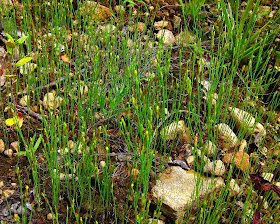The almost-autumnal weather of late was perfect for climbing a steep rocky powerline this past Saturday. My friend Sue and I had climbed up these slopes in late June, when we hid from the sun as much as we could in the deep woods surrounding the clear-cut. But on this pleasantly cool afternoon, the intermittent sun felt welcome as we scrambled up tumbled rocks and pushed our way through hip-deep ferns and flowers.
I was on a mission to find two plants we had located in June, hoping to find them in bloom so that I could collect some specimens to update the botanical atlas for Saratoga County. Neither Prostrate Tick-trefoil (Desmodium rotundifolium) nor Orange-grass St. Johnswort (Hypericum gentianoides) appear on the New York Flora Association's distribution maps for the county, although we had found both species growing abundantly up here in June (albeit without any flowers at that time).
Having seen it before at another location, I knew that the Orange Grass bloomed in late summer/early autumn, but I was only guessing about the bloom time for the Prostrate Tick-trefoil, a species unfamiliar to me. As it happened, I was just beginning to fear we had missed its bloom time, since all I was finding were its yellowing leaves and a few seedpods, when Sue spotted several blooms at the ends of long trailing stems. I was able to get a photo as well as collect a blooming specimen. Prostrate Tick-trefoil is not a rare plant in New York, but this is the only site where I have ever found it.
I had hoped we would find both plants in bloom together, since it's quite a hike to get up to their locations. But when we found a large patch of the Orange Grass, I was disappointed to find it still in bud, with no open flowers. The yellow buds would probably open wide in a day or two, with many other buds still closed up tight within their deep-red sepals.
On second thought, though, I wonder if the deep-red "buds" are not sepals at all, but instead the seedpods of spent blooms. Perhaps if the day had been warmer, all those yellow buds would have been open wide. After searching, I did find a few tiny flowers just starting to spread their petals.
The Prostrate Tick-trefoil had been a new "lifer" for Sue and me when we found it last June, and this August afternoon yielded yet another flower that neither I nor Sue had ever seen before. And believe me, it would have been hard to miss the giant, vividly-colored blooms of Pasture Thistle (Cirsium pumilum), a low-growing thistle native to the northeastern U.S.
Although the whole plant was barely two-feet high, the blooms were the largest thistle flowers I have ever seen, and they were delightfully fragrant as well as beautiful.
That gorgeous thistle alone would have made our efforts worth the trip, but we were also pleased to find many other flowers in bloom, including several other species of Tick-trefoil. These bright-pink flowers were among the widely-branched blooms of Panicled Tick-trefoil (D. paniculatum).
The flowers of Large-bracted Tick-trefoil (D. cuspidatum) were paler and bluer and borne in a tighter cluster than those of D. paniculatum. The leaves are much larger and wider, too, and they narrow to sharp, rather than rounded, points.
Bush Clovers (Lespedeza) were abundant up here on this high open meadow, but they were not the Round-headed ones we were used to commonly seeing at other locations. Here we found Hairy Bush Clover (L. hirta), with its dense spike-like clusters of white flowers touched with pink, and with obviously hairy stems.
Here too, we found the pretty purple blooms of Wandlike Bush Clover (L. intermedia).
Bright yellow sprays of Goldenrod waved in the breeze, which did not interrupt the amorous activities of many pairs of Goldenrod Soldier Beetles.
I hope our pairs of insect lovers manage to escape the clutches of this Goldenrod Crab Spider camouflaged amid the golden florets. But since this little tyke was hardly a quarter inch across, perhaps it lies in wait for smaller prey.
Update: As my friend Sue notes in her comment to this post, this little spider is NOT a Goldenrod Crab Spider, but rather a White-banded Crab Spider (Misumenoides formosipes). According to a very informative website Sue cites, "a view of the eyes from the front can distinguish this species from the similar looking Goldenrod crab spider (Misumena vatia). In the White-banded crab spider, there is a conspicuous, white, transverse ridge below the eyes called a 'clypeal carina.' Misumena vatia does not have such a ridge."
This colorful critter would not be preying on either the spider or the mating beetles, since the Banded Net-winged Beetle dines mostly on nectar or the juices of rotting plants. It's unusual to see a beetle without hard shiny wing covers, but that's how it came to be called a net-winged beetle.
As Sue and I started back down the mountain, we stopped to enjoy the view of the shining river from our high prospect. I very stupidly forgot to carry my GPS device to record the coordinates of where I found the plant specimens I collected, so I shall have to return to make those readings at a later date. Perhaps I will wait until autumn turns the mountainside forest to gorgeous colors. Can you imagine how lovely this view will be then?














Always a thrill to find new species! Great photos as always, and several plants I'm not familiar with. Happy botanizing!
ReplyDeleteSo lovely!
ReplyDeletewhat a great day we had ! your photos look almost 3D they are so vibrant -
ReplyDeleteI looked up that spider, since it looked a little different -- it is a white-banded crab spider according to bug guide - interesting link here: http://www.spiders.us/species/misumenoides-formosipes/
A new spider for us, too !